A movie made for the drive-in market, written, produced, and directed by Leonard Katzmann who has a lot to explain. The IMDB score is 3.8/10. With that in mind…. Some 1960s role modelling kills any nostalgia for those days.
In the distant future year 2000 the Space Probe Taurus is launched, though the probe is called Hope One. The crew members say repeatedly that their destination is Tyrus. Watch and listen but Taurus never puts in an appearance. That slip is characteristic of the standard of this waste of celluloid.
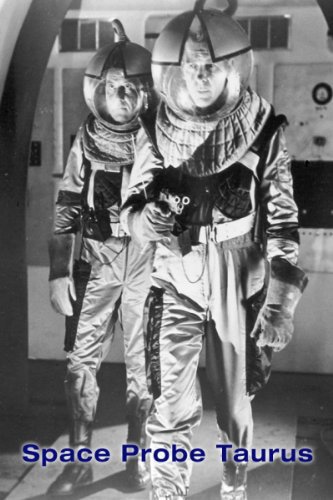 Notice the gat in hand. Wanna shake? Ready to shoot.
Notice the gat in hand. Wanna shake? Ready to shoot.
The crew of four strap into the La-Z-Boy recliners and blast off beyond the solar system. Note: beyond the solar system. Got it? Good, on that more in a moment.
There in deep space they come upon another space ship drifting by. They hail it but no one is picking up the phone. OK, they suit up, and the suits look pretty good (credit the wardrobe department) and float over where they force the door, saying it was not locked. Ah huh, burglars aways say that. Then they enter the engine room and start checking the instruments. Whoops! An alien appears in a rubber suit to protect those delicate instruments. After some mutual staring, the rubber alien refuses the handshake the unwelcome and intruding Hope captain offers, who then promptly shoots the alien with the .45 he was packing into deep space. Bam! So much for first contact. Shake or else!
Wait! It gets worse. They decide to blow up the alien ship. Whatever for? To hide the body of their victim? No, but because gravity will pull it to Earth where it will crash and hurt someone. This from beyond the solar system, remember? Deep space, get it?
Are there any more aliens on board? Are there other alien crew out and about in their rubber suits yet to return to the ship. No one knows. No one checks. No one cares. Boom!
The Probe is called the United States Probe. Not Earth probe, but United States Probe. It fits US foreign policy, bam and boom.
There is more to come. Through no fault of their own they do land on a habitable planet, where they promptly kill the first inhabitant they meet. Consistent anyway. Thereafter they congratulate themselves on finding a habitable world. It will be habitable as soon as all the indigenous inhabitants are murdered. Think Australia. Hence the ‘nullius’ in the alternative title above.
There is no irony in any of these events. Not hint of it. The acting is leaden. The story, well, what story. The special effects are rubber. Could be I am making it sound better than it is. This’ll cork it: Roger Corman made better movies! Thought I would never say that of anything.
The crew of four includes a woman, much to the annoyance of the captain who wants chaps. Bet no one expected that! But she got the job because she is a light weight. Literally. She weighs less than a male scientist. Is this clever or what? (Or what.) The two younger crew men hit on her and she finally relents. The rejected suitor, sacrifices himself to extricate the ship from another blunder. Role modelling, indeed. THE END. Amen.
In the second to last scene we learn that the probe is a desperate effort to find a place to relocate the population of the Earth or is it the United States, for reasons not theretofore mentioned or further explained though i suspected it was the aftermath of a GOP majority. Maybe as the end neared someone thought to justify the mayhem earlier in the film. Hmm. Not likely. Probably filmed that last scene first, a common practice, and then just forgot about it. Something I have tried to do myself.
No one ever watched the last feature at a drive-in, anyway. Wisdom in that, as well as hormones.
 Leonard Katzmann much later.
Leonard Katzmann much later.
Thirty years later Katzmann directed more than sixty episodes of ‘Dallas.’ Atonement in that punishing duty?
Month: October 2017
‘The Atomic Man’ (1955)
It has also been released as ‘Timeslip,’ which reveals the plot. It is a low budget science fiction film.
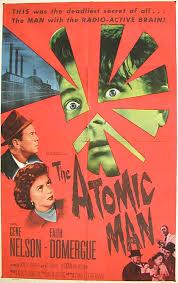
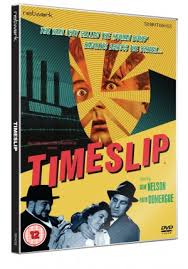
The acting is fine and the direction is crisp in the film noir manner of the era. (It was cheaper to film in low light and so many B movies were noir primarily for this financial reason.) The story is another matter. The science is silly. The villains do their best with underwritten parts. For a thriller there is a lack of urgency.
It was a ’quota quickie’ and that explains its schizophrenia about whether it is American or British. All the cast are British except for the two leads, Gene Nelson and Faith Domergue, but all speak of dollars, not pounds. Newspaper reporter Nelson fastens onto the mystery man pulled from the river who bears an uncanny resemblance to a nuclear scientist splitting atoms at a top top secret installation down the road. Connect the dots.
The secret work is no secret to Nelson who barges in and around with insufferable audacity that only works in movies. Ditto he has no trouble getting into the hospital ward guarded by the police where the victim is lying in a stupor.
Nelson and Domergue are a good team, she being a newspaper photographer.
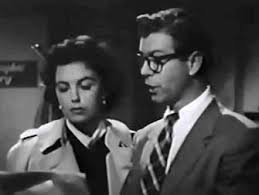 The team at work.
The team at work.
He is the action man and she does the thinking. Sporting a noir trench coat, she figures out the problem and takes several initiatives, unlike the female lead in many films of the era. But she is also stereotypical enough to wait in the car while Nelson does man-stuff, i.e., yelling at people. Don’t blame him, he did not write it.
More interesting than anything in the movie is the public policy of the ‘quota quickie’ in post war Great Britain. Westminster legislated that 25% of all cinema screenings be British made. This was not in the interest of stimulating the British film industry which at the time was working at full capacity. No. The purpose was to reduce the importation of American films by crowding them out of the theatres so that the earrings of imported films would not taken out of the country. Subtle, huh? There was no prohibition on American films, but a squeeze on cinema proprietors to discourage showing them.
However, because the British film industry was already at capacity, many studios subcontracted the films needed to meet that 25% quota to all comers, like the legendary Danziger brothers (who could knock of the unforgettable ‘Devil Girl from Mars’ in ten days), and to American shell companies set up in London in response to this opportunity. These American companies in turn put a few American touches in the films so that they could be shown in the States in the bottom half of a program or a drive-in triple feature. (Those were the days.) The touches might be leads like Nelson and Domergue, references to dollars, or mid-Atlantic accents from Brits.
This practice of subcontracting undermined the purpose of the policy yet complied with it and yet all the same channeled the money into American companies, actors, and writers.
Nelson started as a dancer but three years in the army in World War II ended the dancing days. In movies he played opposite Debbie Reynolds, Doris Day, and Virginia Mayo early in his career but as their stars ascended his did not. Who knows why. In this film he is energetic, times his lines exactly, and knows where to look, as they say behind the camera. Television offered him a second bite of the apple and there he turned to directing and made quite a career of that.
Domergue, once a protege of Howard Hughes, played a scientist in a number of B sci-fi pics like ‘This Island Earth’ (1955), which is a keeper. There is pathos here because plastic surgery figures heavily in the plot of ‘The Atomic Man’ and she herself had extensive plastic surgery as a young woman when a car crash sent her through a windscreen.
The story is by Charles Eric Maine, who also did the screen play; he was a science fiction writer with little interest in and no knowledge of science. It shows.
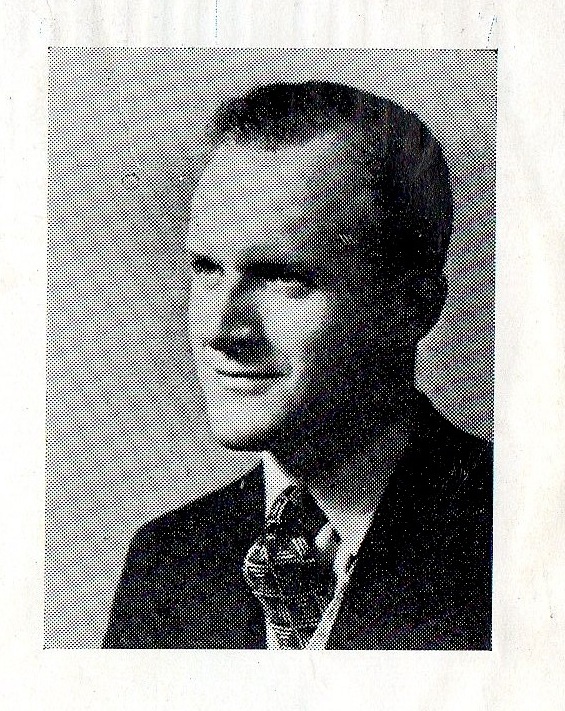
He was really a detective writer who used science fiction conventions to set up his stories, and viewed against those expectations this film is worth more than the 5.4 rating on the IMDB. This film is not science fiction. The action turns around a nuclear research laboratory and that is it. He has a long list of titles ascribed to science fiction.
‘Starship Invasions’ (1977)
For those who thought ‘Battle Beyond the Stars’ (1980) was rock bottom, try this offering.
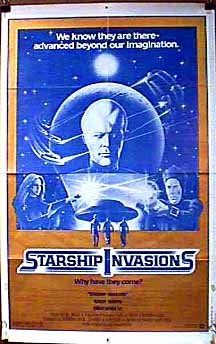
Leading the cast are Christopher Lee and Robert Vaughn. Quality right? Wrong!
The acting is Easter Island stone faces. Lips not moving. Not moving?
The aliens are telepathic; ergo their lips are sealed. Most of the film shows expressionless actors staring at each other with a voiceover for the dialogue. Exciting stuff, not. This has to be the dumbest production decision ever made, well, apart from casting Tom Cruise in anything. Christopher Lee as the chief villain imitates a department store window mannequin in a black onesie with a hood over wires on his head to make him look even stranger than usual. That works. He looks constipated.
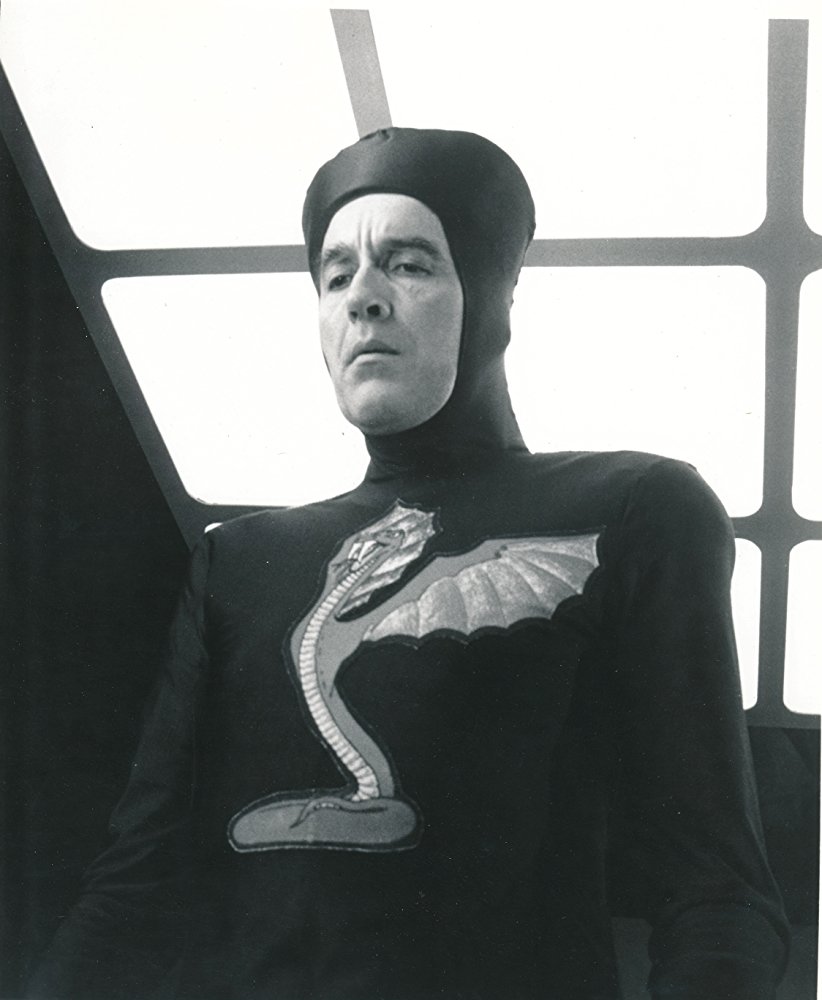 Here is Christopher Lee lips sealed ordering the destruction of the human population of Earth. Ho hum.
Here is Christopher Lee lips sealed ordering the destruction of the human population of Earth. Ho hum.
Even in the midst of a CGI spaceship battle the extras move like mannequins. An alien commander yells to his only underling, ‘Quick, shields up!’ The underling moves like he is underwater to the console, only to discover it has been sabotaged. That is quick? By the way, was this minion the one who failed to do the pre-flight check? After corporate downsizing, the alien is reduced to one underling. No backup.
Vaughn as a UFO scientist has a few lines which he manfully utters, but mostly the aliens read his thoughts. (I could read them, too, namely ‘Get me out of here! I am going to fire my agent!’) The UFOs whiz around, crash onto highways, are sighted by crowds of airforce personnel in a flyover, land in front the Toronto telephone exchange to steal some vital — as if! — computer equipment (1970s telephone routers, evidently picking up a few things for ET to use in calling home), and crash into the tower of the Bank of Montreal (which relocated to the safety of Toronto when the PQ won an election, and now this), while the authorities and media use alternative facts to deny the existence of UFOs. Faux News strikes again. That part is credible.
The one interesting idea in the screenplay is mentioned and then dropped. Early in the going Christopher Lee examines human DNA and concludes that his own race is the offspring of ancient Earthlings. Huh? How did that happen? But Lee puts aside such girly question and…villain that he is, does not hesitate for a moment to order the planetary extermination of his forbears. That intriguing idea was never mentioned again. It is treated in an episode of ‘Captain Future’ (1948) with far more energy and wit.
The Internet Movie Data Base offers a plot summary, which I do not have the will to do so myself. Yes there is a plot of sorts. The rating there of 4.0 seems high, though, as always, some liked it. That 4 is an average; some of the scorers gave it an 8 or so to balance my 1. (A ‘0’ cannot be cast. i know; I’ve tried.) Think about that. The only explanation of this celluloid muddle is the tax credits the Ontario government once offered foreign film companies when it laboured under the delusion it was going to create Onty-wood on the Mississauga. This cheap production was subsidised by Ontario taxpayers. Hence some of the supporting actors, like Vaughn’s screen wife, speak with the Ottawa Valley accent.
‘Battle Beyond the Stars’ (1980)
Another overblown and undercooked science fiction film with a sizeable budget is this entry: ‘Battle Beyond the Stars’ (1980), a CGI vehicle for John-Boy Walton, and little else.
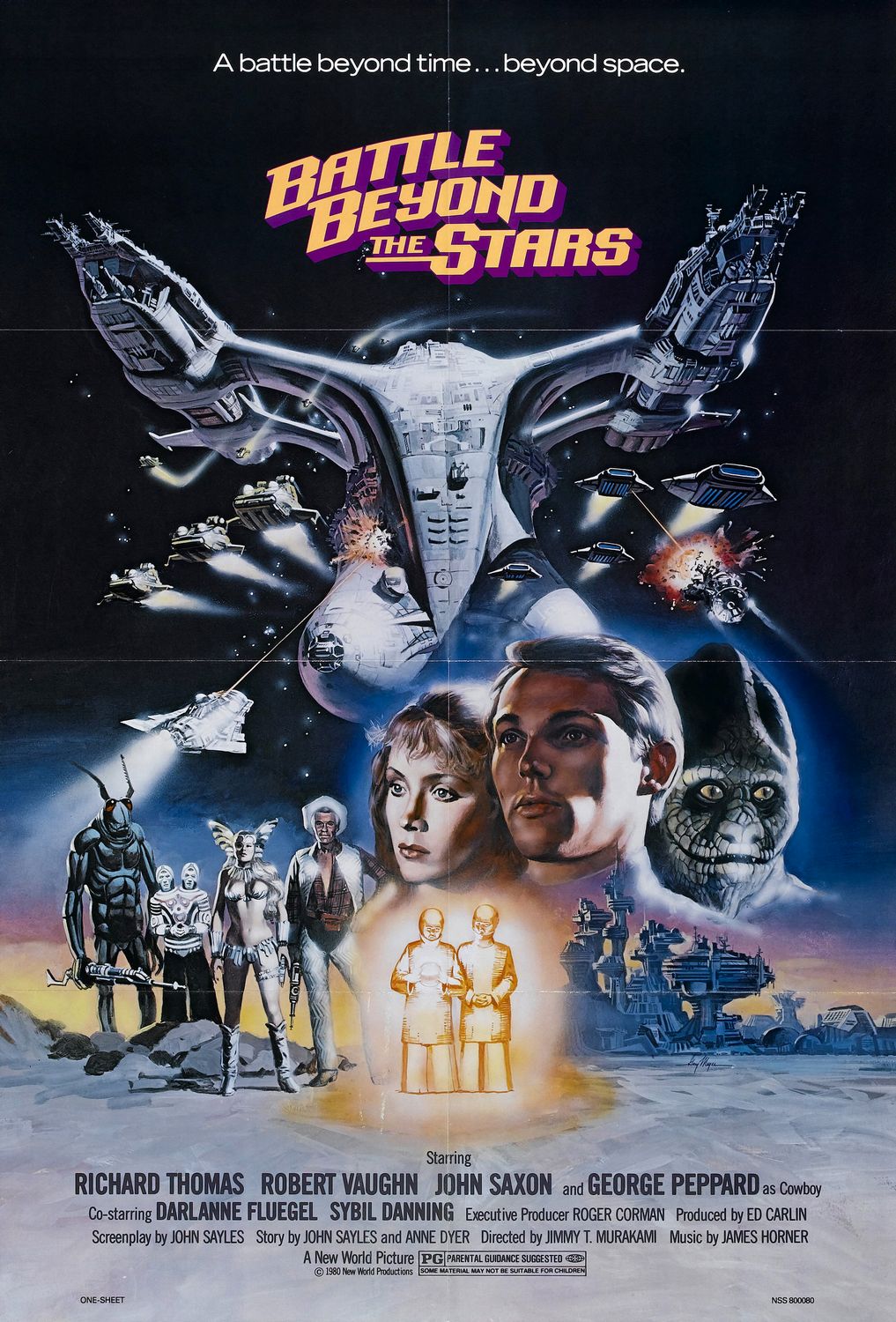
The set-up is intriguing and there are some imaginative elements along with some major talents in supporting roles, but it is decidedly underdone. It transposes ‘The Seven Samurai’ (1954) directed by Akira Kurosawa to outer space via ‘The Magnificent Seven’ directed by John Sturges (1960). Though not credited the word on the web sites is that Roget Corman directed ‘Battle Beyond the Stars.’ That alone would explain why it is so lifeless, listless, and down right lazy. Kurosawa and Sturges could direct a script from the telephone book and make it interesting, not so Corman who could make ‘The Fall of House of Usher boring.’ Not could, did.
The imaginative element was mostly in the creature-features, always a speciality of Corman. There are several but the one that caught my eye was the multiple Nestor who got the only zinger in the dialogue — ‘We always carry a spare.’ In the context it gives chuckle. And the spare comes in handy. (There is pun there for the cognoscenti.)
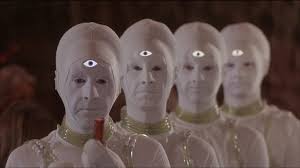 Nestor(s)
Nestor(s)
And Nestor got the only really science fiction element in this shoot ‘em space western with the moving arm. But two moments in 1hr and 44m is too little.
The major talents are Robert Vaughn and John Saxon, both of whom play their parts with deadly earnestness, and George Peppard, who quite obviously wanted to be elsewhere, and should have been. Vaughn reprises his role from the 1960 ‘The Magnificent Seven’ as a world weary, no, galaxy weary, phaser-slinger, though what his particular talents are as a murderer for hire receive no explanation, nor is there any character development apart from his clenched jaw, and ennui filled sighs.
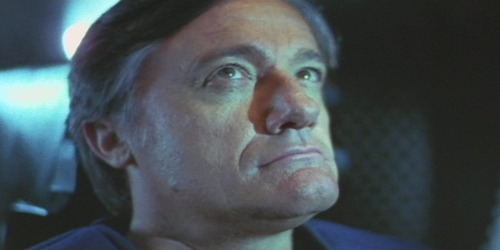 Vaughn and jaw.
Vaughn and jaw.
In contrast, John Saxon is a wonderful one-armed galactic villain! He is steely and focussed enough to burn through steel, as if this role were his chance at the stardom that eluded Carmine Orrico.
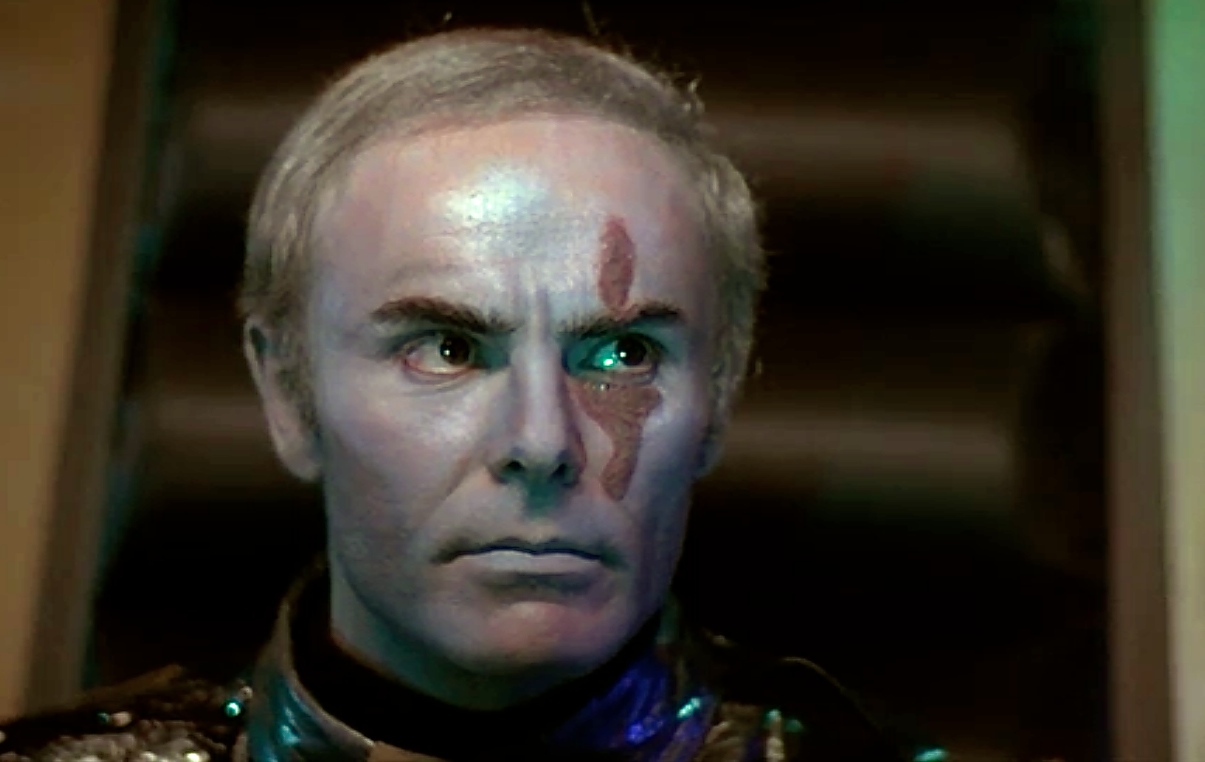 Saxon scowling.
Saxon scowling.
He does not drool nor scratch, but otherwise he has all the mannerisms of a major league Hollywood villain. He shouts at underlings, describes them as idiots, delights in torturing helpless victims, indulges his senses, devises impossible key performance indicators, cuts budgets, wait, he starting to sound like someone for whom I once worked.
A final confrontation between Saxon and Vaughn might have added up to something.
As it is, the crescendo, and I do mean crescendo because it is loud, of the movie is a twenty minute plus CGI shoot out that goes on and on, and on. (I did the crossword while the CGIs duked and nuked it out.) Peppard, Vaughn, and the Valkyrie, and finally Saxon get killed. At that point the film lost all interest for me, while the ever prepubescent John-Boy waxed on.
Did I mention the Valkyrie? No? What an omission!
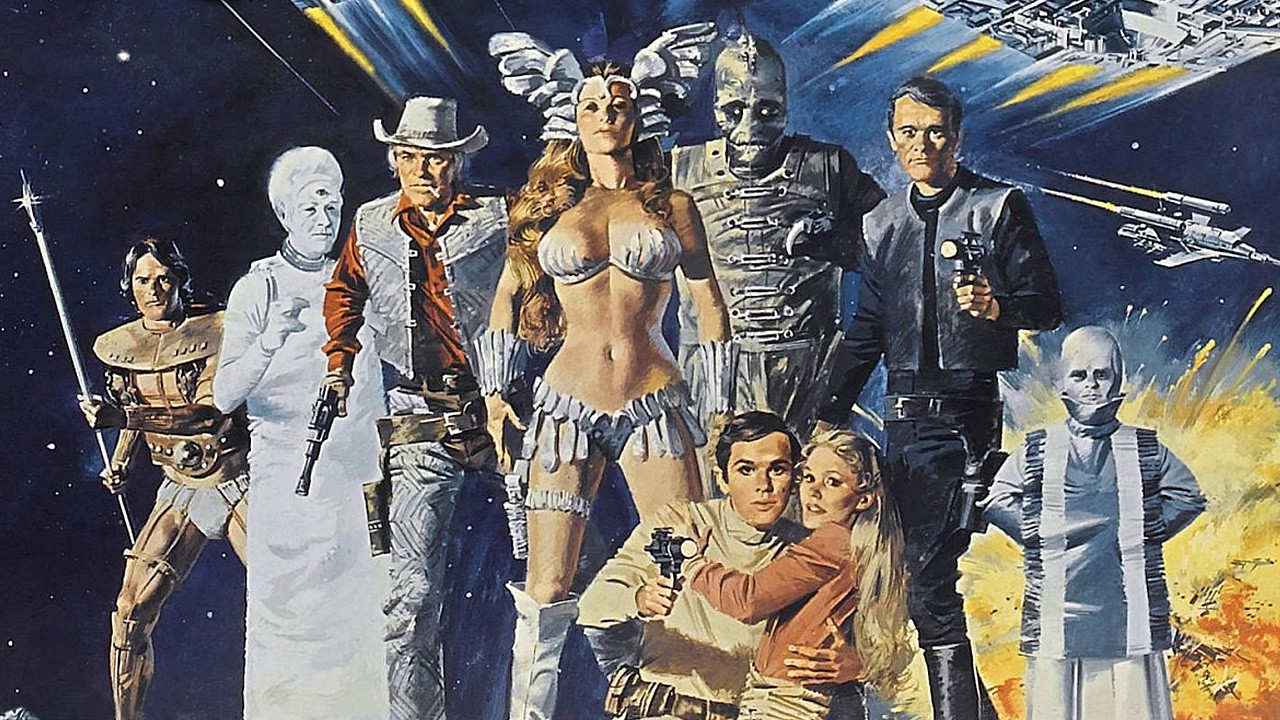 Spot the Valkyrie!
Spot the Valkyrie!
She has to be seen to be believed. Roger Corman can do some things right and she is one of them. Sybil Danning, need I say more, the queen of B-movie babes who started her career, I do not joke, with ‘The Long Swift Sword of Siegfried.’ Lucky Siegfried.
The mystery is how Roger Corman got such talents to work for him as Vaughn, Peppard, Saxon, and, this time let us not forget, Danning. These players are way above his usual payroll. John-Boy must have had some influence.
